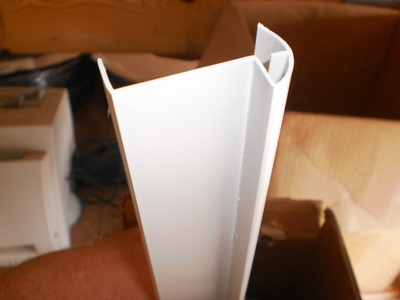Forum Discussion
myredracer
Mar 26, 2016Explorer II
Pretty easy to do. We've had an accordion door and solid door in 2 TTs in the same bedroom location. A solid door is much better IMO as long as it doesn't interfere with anything. You have the option of making it factory original or not too. Myself, I don't like doing a mod unless it looks factory done (except for their not-so-good workmanship, lol).
Plastic RV door jamb is relatively inexpensive and easy to get - comes in different wall thicknesses. Interior RV doors usually use a simple surface mount hinge like in the photo. You can buy RV bedroom/bathroom door locksets like at rvlocksandmore.com for ex. but ordinary residential ones will work.
There are various internet sources for doors such as discountcamperparts.com Some dealers that sell parts and accessories sometimes have a section for discount odds and ends (have seen doors at one dealer). Our interior doors are 20" wide x 6' high x 1 3/8" thick. You'll want the door undercut for air flow - ours are 2" off the floor and have seen 3-4". Visit a door supplier if you have one nearby and may find something suitable. Width is not critical. Maybe get an unfinished door and stain it to match (or close enough to existing).
If do want to make it look factory, there are 2 snags I can think of. One is getting some luan plywood to match the existing walls. It's kind of generic and may be able to get some from a local parts vendor but *might* not be cheap. Your pass-through storage compartment likely has luan plywood the same as the interior on one or both sides. You should be able to peel off a whole piece for the new door and replace it with any old piece of 1/8" plywood. Go to a plywood specialty shop if you have one nearby. The other snag would be getting trim to match the existing. You could buy some maple or oak or some other species and stain it to match. If you get the right RV door jamb, you won't need the wood trim (faux wood).
Screwing into the luan plywood walls and ceilings is not a problem - that's what they do at the factories. Use #8 wood screws. Exterior walls should be at least 1" thick. Choose screw length enough to penetrate the plywood by maybe 1/2" to be safe. You won't need to screw into a stud, but if you have one to screw into, great.
FWIW, on any older RV, one of the 1st things that should be done is to check the exterior caulking for leaks. Leaks are common if not regularly checked and recaulked as needed. A leak test is the best method for finding leaks.


Plastic RV door jamb is relatively inexpensive and easy to get - comes in different wall thicknesses. Interior RV doors usually use a simple surface mount hinge like in the photo. You can buy RV bedroom/bathroom door locksets like at rvlocksandmore.com for ex. but ordinary residential ones will work.
There are various internet sources for doors such as discountcamperparts.com Some dealers that sell parts and accessories sometimes have a section for discount odds and ends (have seen doors at one dealer). Our interior doors are 20" wide x 6' high x 1 3/8" thick. You'll want the door undercut for air flow - ours are 2" off the floor and have seen 3-4". Visit a door supplier if you have one nearby and may find something suitable. Width is not critical. Maybe get an unfinished door and stain it to match (or close enough to existing).
If do want to make it look factory, there are 2 snags I can think of. One is getting some luan plywood to match the existing walls. It's kind of generic and may be able to get some from a local parts vendor but *might* not be cheap. Your pass-through storage compartment likely has luan plywood the same as the interior on one or both sides. You should be able to peel off a whole piece for the new door and replace it with any old piece of 1/8" plywood. Go to a plywood specialty shop if you have one nearby. The other snag would be getting trim to match the existing. You could buy some maple or oak or some other species and stain it to match. If you get the right RV door jamb, you won't need the wood trim (faux wood).
Screwing into the luan plywood walls and ceilings is not a problem - that's what they do at the factories. Use #8 wood screws. Exterior walls should be at least 1" thick. Choose screw length enough to penetrate the plywood by maybe 1/2" to be safe. You won't need to screw into a stud, but if you have one to screw into, great.
FWIW, on any older RV, one of the 1st things that should be done is to check the exterior caulking for leaks. Leaks are common if not regularly checked and recaulked as needed. A leak test is the best method for finding leaks.

About Travel Trailer Group
44,028 PostsLatest Activity: Mar 15, 2025